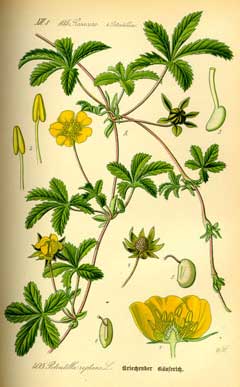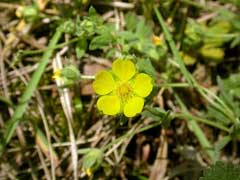 |
|
http://commons.wikimedia.org/wiki/File:Illustration_Potentilla_reptans0.jpg |
 |
| http://commons.wikimedia.org/wiki/User:Dysmachus |
Translate this page:
Summary
Physical Characteristics

 Potentilla reptans is a PERENNIAL growing to 1 m (3ft 3in) by 1 m (3ft 3in).
Potentilla reptans is a PERENNIAL growing to 1 m (3ft 3in) by 1 m (3ft 3in).
See above for USDA hardiness. It is hardy to UK zone 5 and is not frost tender. It is in flower from June to September. The species is hermaphrodite (has both male and female organs) and is pollinated by Bees, flies. The plant is self-fertile.
Suitable for: light (sandy), medium (loamy) and heavy (clay) soils and prefers well-drained soil. Suitable pH: mildly acid, neutral and basic (mildly alkaline) soils. It cannot grow in the shade. It prefers dry or moist soil.
UK Hardiness Map
US Hardiness Map
Synonyms
Plant Habitats
Meadow;
Edible Uses
Edible Parts: Leaves
Edible Uses:
Young leaves - raw[7]. A useful addition to salads[7].
References More on Edible Uses
Medicinal Uses
Plants For A Future can not take any responsibility for any adverse effects from the use of plants. Always seek advice from a professional before using a plant medicinally.
Antidiarrhoeal Antispasmodic Astringent Febrifuge Odontalgic
Both the roots and the herb are antispasmodic, astringent and febrifuge[4, 7, 9, 54, 240]. An infusion of the dried herb is used in the treatment of diarrhoea etc, it is also used as a gargle for sore throats and is used externally as an astringent lotion[4]. A concentrated decoction of the root relieves toothache[7].
References More on Medicinal Uses
The Bookshop: Edible Plant Books
Our Latest books on Perennial Plants For Food Forests and Permaculture Gardens in paperback or digital formats.

Edible Tropical Plants
Food Forest Plants for Hotter Conditions: 250+ Plants For Tropical Food Forests & Permaculture Gardens.
More

Edible Temperate Plants
Plants for Your Food Forest: 500 Plants for Temperate Food Forests & Permaculture Gardens.
More

More Books
PFAF have eight books available in paperback and digital formats. Browse the shop for more information.
Shop Now
Other Uses
Cosmetic
The plant is an ingredient in many anti-wrinkle cosmetic preparations for the skin[7].
Special Uses
References More on Other Uses
Cultivation details
Easily grown in a well-drained loam, preferring a dry position in full sun but tolerating shade[1]. Prefers an alkaline soil but tolerates a slightly acid soil[200]. The plant spreads vigorously by means of runners and can be invasive with new runners up to 1.5 metres long being produced each year[1, 4]. Members of this genus are rarely if ever troubled by browsing deer[233]. The flowers are partially closed in dull weather and close completely of a night time[4]. When closing, self-fertilisation is affected because the anthers are caused to touch the stigmas[4].
References Carbon Farming Information and Carbon Sequestration Information
Temperature Converter
Type a value in the Celsius field to convert the value to Fahrenheit:
Fahrenheit:
The PFAF Bookshop
Plants For A Future have a number of books available in paperback and digital form. Book titles include Edible Plants, Edible Perennials, Edible Trees,Edible Shrubs, Woodland Gardening, and Temperate Food Forest Plants. Our new book is Food Forest Plants For Hotter Conditions (Tropical and Sub-Tropical).
Shop Now
Plant Propagation
Seed - sow early spring or autumn in a cold frame. When they are large enough to handle, prick the seedlings out into individual pots and grow them on in the greenhouse for their first winter. Plant them out into their permanent positions in late spring or early summer, after the last expected frosts. Division in spring or autumn. Larger divisions can be planted out direct into their permanent positions. We have found that it is better to pot up the smaller divisions and grow them on in light shade in a cold frame until they are well established before planting them out in late spring or early summer.
Other Names
If available other names are mentioned here
Native Range
TEMPERATE ASIA: Saudi Arabia, Afghanistan, Cyprus, Iran, Iraq (north), Jordan, Lebanon, Syria, Turkey, Russian Federation-Ciscaucasia (Ciscaucasia), Armenia, Azerbaijan, Georgia, Russian Federation (Dagestan), Kazakhstan, Kyrgyzstan, Tajikistan, Turkmenistan, Uzbekistan, China (Gansu Sheng, Hebei Sheng, Henan Sheng, Jiangsu Sheng, Nei Mongol Zizhiqu, Shaanxi Sheng, Shandong Sheng, Shanxi Sheng, Sichuan Sheng, Xinjiang Uygur Zizhiqu, Yunnan Sheng, Zhejiang Sheng) TROPICAL ASIA: India (northwest), Pakistan EUROPE: Denmark, Finland (south), United Kingdom, Ireland, Sweden (south), Austria, Switzerland, Czech Republic, Germany, Hungary, Poland, Slovakia, Russian Federation (European part), Belarus, Estonia, Lithuania, Latvia, Moldova, Ukraine (incl. Krym), Albania, Bulgaria, Bosnia and Herzegovina, Greece (incl. Crete), Croatia, Italy (incl. Sardinia, Sicily), North Macedonia, Montenegro, Romania, Serbia, Slovenia, Spain (incl. Baleares), France (incl. Corsica), Portugal AFRICA: Algeria, Libya (north), Morocco, Tunisia
Weed Potential
Right plant wrong place. We are currently updating this section.
Please note that a plant may be invasive in one area but may not in your area so it's worth checking.
See readers comments below.
Conservation Status
IUCN Red List of Threatened Plants Status :

| Related Plants
|
| Latin Name | Common Name | Habit | Height | Hardiness | Growth | Soil | Shade | Moisture | Edible | Medicinal | Other |
| Potentilla anserina | Silverweed | Perennial | 0.3 |
4-8
| F | LMH | SN | M | 3 | 3 | 2 |
| Potentilla bicolor | | Perennial | 1.0 |
5-9
| | LMH | SN | M | 1 | 0 | |
| Potentilla chinensis | Chinese Cinquefoil | Perennial | 0.6 |
-
| | LMH | SN | M | 1 | 1 | |
| Potentilla cryptotaeniae | | Perennial | 1.0 |
-
| | LMH | SN | M | 0 | 1 | |
| Potentilla discolor | | Perennial | 0.3 |
-
| | LMH | SN | M | 2 | 1 | |
| Potentilla egedei | Pacific Silverweed | Perennial | 0.5 |
4-8
| | LMH | SN | M | 2 | 1 | |
| Potentilla erecta | Tormentil, Erect cinquefoil | Perennial | 0.3 |
4-8
| | LMH | SN | M | 1 | 3 | 1 |
| Potentilla fragarioides | | Perennial | 0.3 |
-
| | LMH | SN | M | 1 | 1 | |
| Potentilla fruticosa | Shrubby Cinquefoil, Potentilla | Shrub | 1.2 |
2-6
| M | LMH | SN | M | 1 | 1 | 3 |
| Potentilla glandulosa | Gland Cinquefoil, Sticky cinquefoil, Arizona cinquefoil, Ashland cinquefoil, Ewan's cinquefoil, Hans | Perennial | 0.6 |
6-9
| | LMH | SN | M | 1 | 1 | |
| Potentilla hippiana | Woolly Cinquefoil | Perennial | 0.6 |
5-9
| | LMH | SN | M | 0 | 1 | |
| Potentilla kleiniana | | Perennial | 0.3 |
-
| | LMH | SN | M | 1 | 1 | |
| Potentilla multifida | | Perennial | 0.3 |
3-7
| | LMH | SN | M | 2 | 0 | |
| Potentilla nepalensis | Nepal Cinquefoil, Cinquefoil | Perennial | 0.6 |
5-10
| M | LMH | SN | M | 2 | 1 | |
| Potentilla norvegica | Norwegian Cinquefoil | Annual/Perennial | 0.3 |
3-7
| | LMH | SN | M | 0 | 1 | |
| Potentilla palustris | Marsh Cinquefoil | Perennial | 0.5 |
3-7
| | LMH | SN | We | 1 | 1 | 1 |
| Potentilla recta | Rough-Fruited Cinquefoil, Erect cinquefoil | Perennial | 0.6 |
4-8
| | LMH | SN | M | 2 | 1 | 0 |
| Potentilla rupestris | Rock Cinquefoil | Perennial | 0.5 |
4-8
| | LMH | SN | DM | 1 | 0 | |
| Potentilla simplex | Old Field Cinquefoil, Common cinquefoil | Perennial | 0.1 |
3-7
| | LMH | SN | M | 0 | 1 | 0 |
| Potentilla supina | | Annual/Perennial | 0.3 |
-
| | LMH | SN | M | 1 | 1 | |
|
Growth: S = slow M = medium F = fast. Soil: L = light (sandy) M = medium H = heavy (clay). pH: A = acid N = neutral B = basic (alkaline). Shade: F = full shade S = semi-shade N = no shade. Moisture: D = dry M = Moist We = wet Wa = water.
Now available:
Food Forest Plants for Mediterranean Conditions
350+ Perennial Plants For Mediterranean and Drier Food Forests and Permaculture Gardens.
[Paperback and eBook]
This is the third in Plants For A Future's series of plant guides for food forests tailored to
specific climate zones. Following volumes on temperate and tropical ecosystems, this book focuses
on species suited to Mediterranean conditions—regions with hot, dry summers and cool, wet winters,
often facing the added challenge of climate change.
Read More
Expert comment
Author
L.
Botanical References
17200
Links / References
For a list of references used on this page please go here
Readers comment